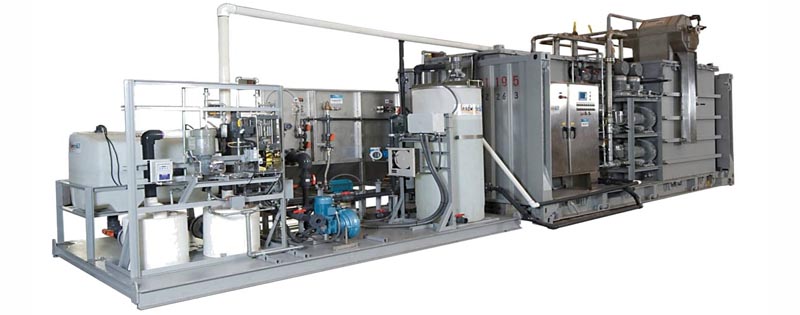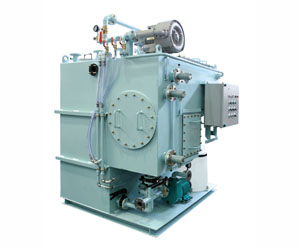
Welcome to Leader in Water- & Wastewater Solution
Welcome to Leader in Water- & Wastewater Solution

Package plants are pre-manufactured treatment facilities used to treat wastewater in small communities or on individual properties.
The most common types of package plants are extended aeration plants, sequencing batch reactors, oxidation ditches, contact stabilization plants, rotating biological contractors, and physical/chemical processes. This fact sheet focuses on the first three, all of which are biological aeration processes.

The extended aeration process is one modification of the activated sludge process which provides biological treatment for the removal of biodegradable organic wastes under aerobic conditions. Air may be supplied by mechanical or diffused aeration to provide the oxygen required to sustain the aerobic biological process. Mixing must be provided by aeration or mechanical means to maintain the microbial organisms in contact with the dissolved organics. In addition, the pH must be controlled to optimize the biological process and essential nutrients must be present to facilitate biological growth and the continuation of biological degradation.
Wastewater enters the treatment system and is typically screened immediately to remove large suspended, settle able, or floating solids that could interfere with or damage equipment downstream in the process. Wastewater may then pass through a grinder to reduce large particles that are not captured in the screening process. If the plant requires the flow to be regulated.
the effluent will then flow into equalization basins which regulate peak wastewater flow rates. Wastewater then enters the aeration chamber, where it is mixed and oxygen is provided to the microorganisms. The mixed liquor then flows to a clarifier or settling chamber where most microorganisms settle to the bottom of the clarifier and a portion are pumped back to the incoming wastewater at the beginning of the plant. This returned material is the return activated sludge (RAS). The material that is not returned, the waste activated sludge (WAS), is removed for treatment and disposal. The clarified wastewater then flows over a weir and into a collection channel before being diverted to the disinfection system.
Extended aeration package plants consist of a steel tank that is compartmentalized into flow equalization, aeration, clarification, disinfection, and aerated sludge holding/digestion segments. Extended aeration systems are typically manufactured to treat wastewater flow rates between 0.002 to 0.1 MGD. Use of concrete tanks may be preferable for larger sizes.
• Plants are easy to operate, as many are manned for a maximum of two or three hours per day
• Extended aeration processes are often better at handling organic loading and flow fluctuations, as there is a greater detention time for the nutrients to be assimilated by microbes
• Systems are easy to install, as they are shipped in one or two pieces and then mounted on an on-site concrete pad, above or below grade
• Systems are odor free, can be installed in most locations, have a relatively small footprint, and can be landscaped to match the surrounding area
• Extended aeration systems have a relatively low sludge yield due to long sludge ages, can be designed to provide nitrification, and do not require a primary clarifier
• Extended aeration plants do not achieve De nitrification or phosphorus removal without additional unit processes
• Flexibility is limited to adapt to changing effluent requirements resulting from regulatory changes
• A longer aeration period requires more energy
• Systems require a larger amount of space and tankage than other “higher rate” processes, which have shorter aeration detention times
A sequencing batch reactor (SBR) is a variation of the activated sludge process. As a fill and draw or batch process, all biological treatment phases occur in a single tank. This differs from the conventional flow through activated sludge process in that SBRs do not require separate tanks for aeration and sedimentation. SBR systems contain either two or more reactor tanks that are operated in parallel, or one equalization tank and one reactor tank. The type of tank used depends on the wastewater flow characteristics (e.g. high or low volume). While this setup allows the system to accommodate continuous influent flow, it does not provide for disinfection or holding for aerated sludge.
There are many types of SBR systems, including continuous influent/time based, non-continuous influent/time based, volume based, an intermittent cycle system (a SBR that utilizes jet aeration). The type of SBR system used depends on site and wastewater characteristics as well as the needs of the area or community installing the unit. Package SBRs are typically manufactured to treat wastewater flow rates between 0.01 and 0.2 MGD.
The influent flow first goes through a screening process before entering the SBR. The waste is then treated in a series of batch. There are normally five phases in the SBR treatment cycle: fill, react, settle, decant, and idle. The length of time that each phase occurs is controlled by a programmable logic controller (PLC), which allows the system to be controlled from remote locations. In the fill phase, raw wastewater enters the basin, where it is mixed with settled biomass from the previous cycle.
Some aeration may occur during this phase. Then, in the react phase, the basin is aerated, allowing oxidation and nitrification to occur. During the settling phase, aeration and mixing are suspended and the solids are allowed to settle. The treated wastewater is then discharged from the basin in the decant phase. In the final phase, the basin is idle as it waits for the start of the next cycle. During this time, part of the solids are removed from the basin and disposed of as waste sludge.
Sludge wasting is an important step in the SBR process and largely affects system performance. It is not considered a basic phase since the sludge is not wasted at a specific time period during the cycle. The quantity and rate of wasting is determined by performance requirements. An SBR system does not require an RAS system, as both aeration and settling occur in the same tank. This prevents any sludge from being lost during the react step and eliminates the need to return sludge from the clarifier to the aeration chamber.
• SBRs can consistently perform nitrification as well as De nitrification and phosphorous removal
• SBRs have large operational flexibility
• The ability to control substrate tension within the system allows for optimization of treatment efficiency and control over nitrogen removal, filamentous organisms, and the overall stability of the process
• Since all the unit processes are operated in a single tank, there is no need to optimize aeration and decanting to comply with power requirements and lower decant discharge rates
• Sludge bulking is not a problem
• Significant reductions in nitrate nitrogen can occur by incorporating an anoxic cycle in the system
• SBRs have little operation and maintenance problems
• Systems require less space than extended aeration plants of equal capacity
• SBRs can be manned part time from remote locations, and operational changes can be made easily
• The system allows for automatic and positive control of mixed liquor suspended solids (MLSS) concentration and solids retention time (SRT) through the use of sludge wasting
• It is hard to adjust the cycle times for small communities
• Post equalization may be required where more treatment is needed
• Sludge must be disposed frequently
• Specific energy consumption is high
An oxidation ditch, a modified form of the activated sludge process, is an aerated, long term, complete mix process. Many systems are designed to operate as extended aeration systems. Typical oxidation ditch treatment systems consist of a single or multi-channel configuration within a ring, oval, or horseshoe-shaped basin. Horizontally or vertically mounted aerators provide aeration, circulation, and oxygen transfer in the ditch.
Package oxidation ditches are typically manufactured in sizes that treat wastewater flow rates between 0.01 and 0.5 MGD. Raw wastewater is first screened before entering the oxidation ditch. Depending on the system size, a grit chamber may be required. Once inside the ditch, the wastewater is aerated with mechanical surface or submersible aerators that propel the mixed liquor around the channel at velocities high enough to prevent solids deposition. The aerator ensures that there is sufficient oxygen in the fluid for the microbes and adequate mixing to ensure constant contact between the organisms and the food supply.
Oxidation ditches tend to operate in an extended aeration mode consisting of long hydraulic and solids retention times which allow more organic matter to break down. Treated sewage moves to the settling tank or final clarifier, where the Bio- solids and water separate. Wastewater then moves to other treatment processes while sludge is removed. Part of it is returned to the ditch as RAS, while the rest is removed from the process as the waste activated sludge (WAS). WAS is wasted either continuously or daily and must be stabilized prior to disposal or beneficial reuse.
• Systems are well-suited for treating typical domestic waste, have moderate energy requirements, and work effectively under most types of weather
• Oxidation ditches provide an inexpensive wastewater treatment option with both low operation and maintenance costs and operational needs
• Systems can be used with or without clarifiers, which affects flexibility and cost
• Systems consistently provide high quality effluent in terms of TSS, BOD, and ammonia levels
• Oxidation ditches have a relatively low sludge yield, require a moderate amount of operator skill, and are capable of handling shock and hydraulic loadings
• Oxidation ditches can be noisy due to mixer/aeration equipment, and tend to produce odors when not operated correctly
• Biological treatment is unable to treat highly toxic waste streams
• Systems have a relatively large footprint
• Systems have less flexibility should regulations for effluent requirements change